Business Structures, Objectives, and Organizational Analysis Report
VerifiedAdded on 2021/01/01
|12
|3166
|102
Report
AI Summary
This report provides a comprehensive analysis of various organizational structures, encompassing public, private, and voluntary sectors. It delves into the types and purposes of organizations, examining their legal structures and illustrating these concepts with case studies of the National Health Service (NHS), Iceland Foods, and the National Trust. The report explores the size and scope of these organizations, elucidating the relationships between organizational functions such as marketing, finance, human resources, and production, and how these functions contribute to the achievement of business objectives. It further investigates how organizational structure, size, and scope are interlinked with business objectives and the goods and services provided. Finally, the report offers a critical analysis of the complexities inherent in different business structures and their interrelationships with organizational functions, providing valuable insights into the dynamics of organizational management and strategy.

Individual report
Paraphrase This Document
Need a fresh take? Get an instant paraphrase of this document with our AI Paraphraser
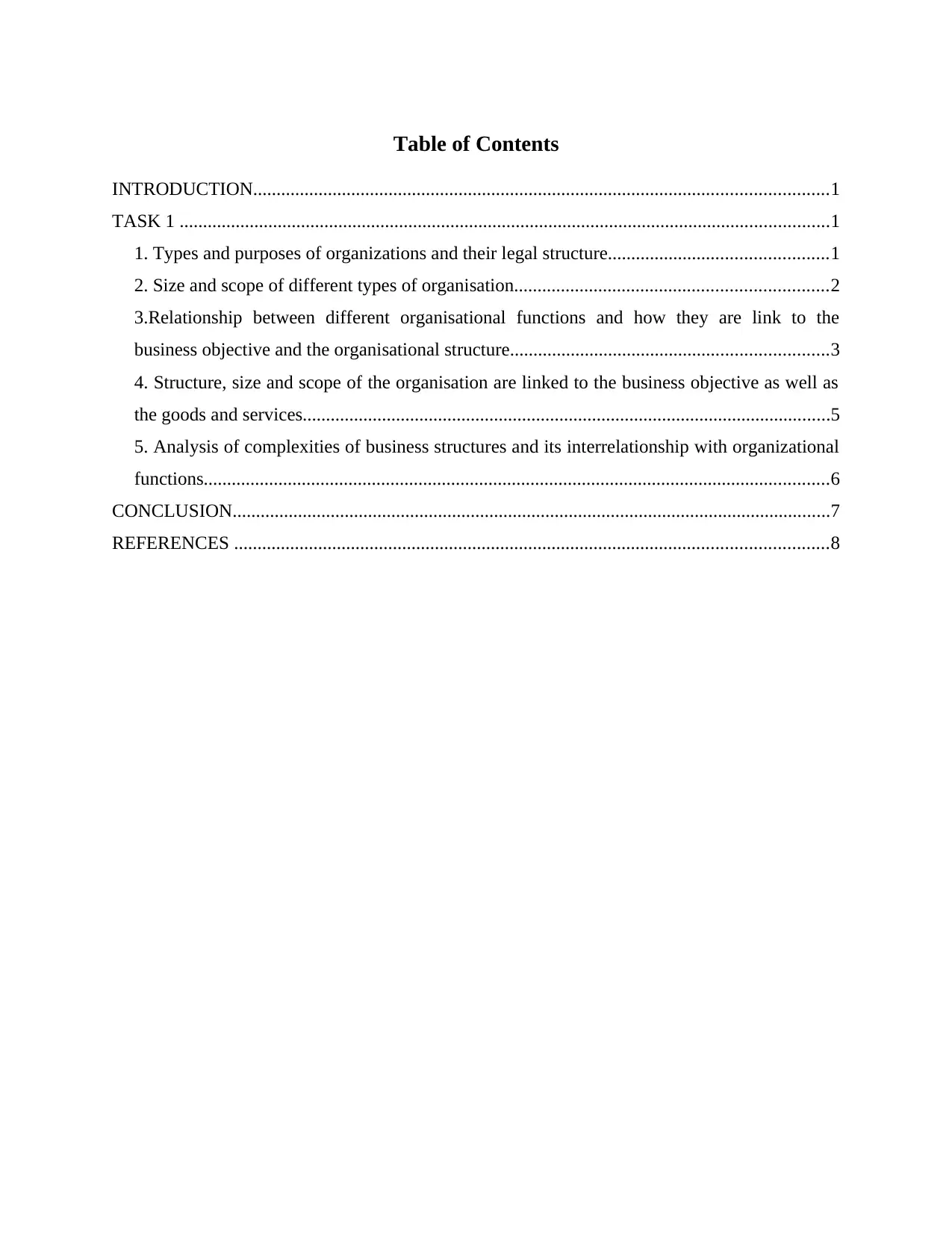
Table of Contents
INTRODUCTION...........................................................................................................................1
TASK 1 ...........................................................................................................................................1
1. Types and purposes of organizations and their legal structure...............................................1
2. Size and scope of different types of organisation...................................................................2
3.Relationship between different organisational functions and how they are link to the
business objective and the organisational structure....................................................................3
4. Structure, size and scope of the organisation are linked to the business objective as well as
the goods and services.................................................................................................................5
5. Analysis of complexities of business structures and its interrelationship with organizational
functions......................................................................................................................................6
CONCLUSION................................................................................................................................7
REFERENCES ...............................................................................................................................8
INTRODUCTION...........................................................................................................................1
TASK 1 ...........................................................................................................................................1
1. Types and purposes of organizations and their legal structure...............................................1
2. Size and scope of different types of organisation...................................................................2
3.Relationship between different organisational functions and how they are link to the
business objective and the organisational structure....................................................................3
4. Structure, size and scope of the organisation are linked to the business objective as well as
the goods and services.................................................................................................................5
5. Analysis of complexities of business structures and its interrelationship with organizational
functions......................................................................................................................................6
CONCLUSION................................................................................................................................7
REFERENCES ...............................................................................................................................8

⊘ This is a preview!⊘
Do you want full access?
Subscribe today to unlock all pages.

Trusted by 1+ million students worldwide
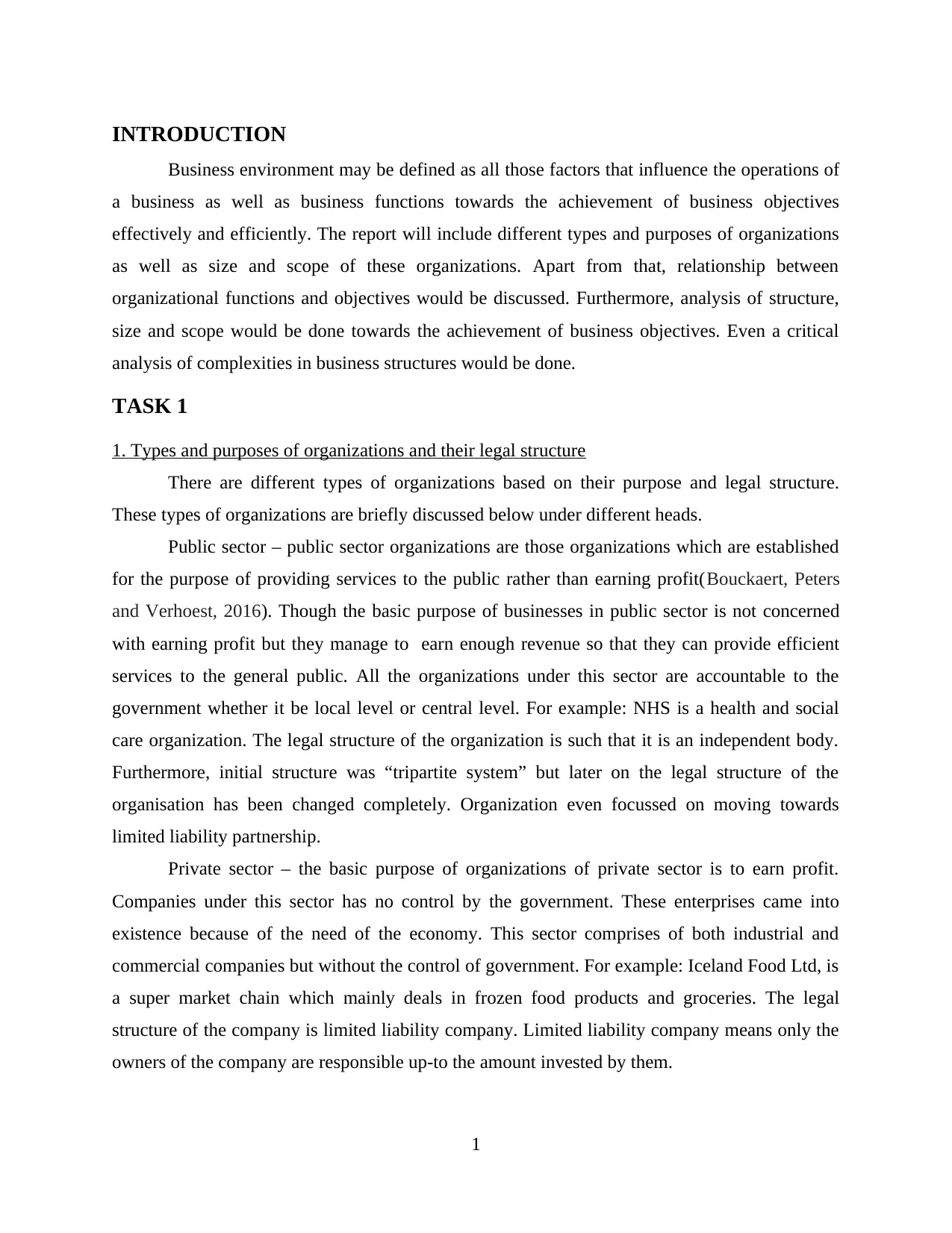
INTRODUCTION
Business environment may be defined as all those factors that influence the operations of
a business as well as business functions towards the achievement of business objectives
effectively and efficiently. The report will include different types and purposes of organizations
as well as size and scope of these organizations. Apart from that, relationship between
organizational functions and objectives would be discussed. Furthermore, analysis of structure,
size and scope would be done towards the achievement of business objectives. Even a critical
analysis of complexities in business structures would be done.
TASK 1
1. Types and purposes of organizations and their legal structure
There are different types of organizations based on their purpose and legal structure.
These types of organizations are briefly discussed below under different heads.
Public sector – public sector organizations are those organizations which are established
for the purpose of providing services to the public rather than earning profit(Bouckaert, Peters
and Verhoest, 2016). Though the basic purpose of businesses in public sector is not concerned
with earning profit but they manage to earn enough revenue so that they can provide efficient
services to the general public. All the organizations under this sector are accountable to the
government whether it be local level or central level. For example: NHS is a health and social
care organization. The legal structure of the organization is such that it is an independent body.
Furthermore, initial structure was “tripartite system” but later on the legal structure of the
organisation has been changed completely. Organization even focussed on moving towards
limited liability partnership.
Private sector – the basic purpose of organizations of private sector is to earn profit.
Companies under this sector has no control by the government. These enterprises came into
existence because of the need of the economy. This sector comprises of both industrial and
commercial companies but without the control of government. For example: Iceland Food Ltd, is
a super market chain which mainly deals in frozen food products and groceries. The legal
structure of the company is limited liability company. Limited liability company means only the
owners of the company are responsible up-to the amount invested by them.
1
Business environment may be defined as all those factors that influence the operations of
a business as well as business functions towards the achievement of business objectives
effectively and efficiently. The report will include different types and purposes of organizations
as well as size and scope of these organizations. Apart from that, relationship between
organizational functions and objectives would be discussed. Furthermore, analysis of structure,
size and scope would be done towards the achievement of business objectives. Even a critical
analysis of complexities in business structures would be done.
TASK 1
1. Types and purposes of organizations and their legal structure
There are different types of organizations based on their purpose and legal structure.
These types of organizations are briefly discussed below under different heads.
Public sector – public sector organizations are those organizations which are established
for the purpose of providing services to the public rather than earning profit(Bouckaert, Peters
and Verhoest, 2016). Though the basic purpose of businesses in public sector is not concerned
with earning profit but they manage to earn enough revenue so that they can provide efficient
services to the general public. All the organizations under this sector are accountable to the
government whether it be local level or central level. For example: NHS is a health and social
care organization. The legal structure of the organization is such that it is an independent body.
Furthermore, initial structure was “tripartite system” but later on the legal structure of the
organisation has been changed completely. Organization even focussed on moving towards
limited liability partnership.
Private sector – the basic purpose of organizations of private sector is to earn profit.
Companies under this sector has no control by the government. These enterprises came into
existence because of the need of the economy. This sector comprises of both industrial and
commercial companies but without the control of government. For example: Iceland Food Ltd, is
a super market chain which mainly deals in frozen food products and groceries. The legal
structure of the company is limited liability company. Limited liability company means only the
owners of the company are responsible up-to the amount invested by them.
1
Paraphrase This Document
Need a fresh take? Get an instant paraphrase of this document with our AI Paraphraser
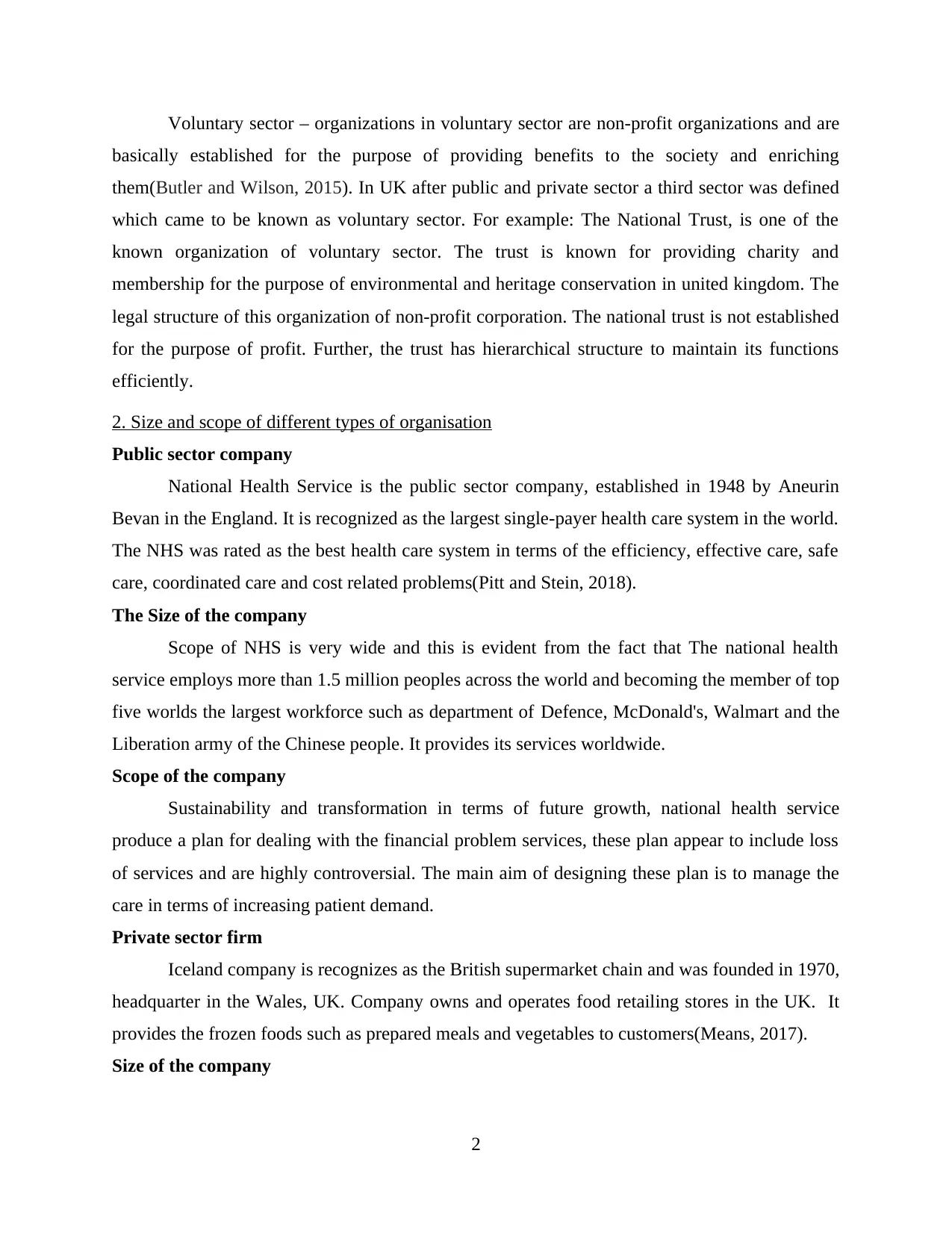
Voluntary sector – organizations in voluntary sector are non-profit organizations and are
basically established for the purpose of providing benefits to the society and enriching
them(Butler and Wilson, 2015). In UK after public and private sector a third sector was defined
which came to be known as voluntary sector. For example: The National Trust, is one of the
known organization of voluntary sector. The trust is known for providing charity and
membership for the purpose of environmental and heritage conservation in united kingdom. The
legal structure of this organization of non-profit corporation. The national trust is not established
for the purpose of profit. Further, the trust has hierarchical structure to maintain its functions
efficiently.
2. Size and scope of different types of organisation
Public sector company
National Health Service is the public sector company, established in 1948 by Aneurin
Bevan in the England. It is recognized as the largest single-payer health care system in the world.
The NHS was rated as the best health care system in terms of the efficiency, effective care, safe
care, coordinated care and cost related problems(Pitt and Stein, 2018).
The Size of the company
Scope of NHS is very wide and this is evident from the fact that The national health
service employs more than 1.5 million peoples across the world and becoming the member of top
five worlds the largest workforce such as department of Defence, McDonald's, Walmart and the
Liberation army of the Chinese people. It provides its services worldwide.
Scope of the company
Sustainability and transformation in terms of future growth, national health service
produce a plan for dealing with the financial problem services, these plan appear to include loss
of services and are highly controversial. The main aim of designing these plan is to manage the
care in terms of increasing patient demand.
Private sector firm
Iceland company is recognizes as the British supermarket chain and was founded in 1970,
headquarter in the Wales, UK. Company owns and operates food retailing stores in the UK. It
provides the frozen foods such as prepared meals and vegetables to customers(Means, 2017).
Size of the company
2
basically established for the purpose of providing benefits to the society and enriching
them(Butler and Wilson, 2015). In UK after public and private sector a third sector was defined
which came to be known as voluntary sector. For example: The National Trust, is one of the
known organization of voluntary sector. The trust is known for providing charity and
membership for the purpose of environmental and heritage conservation in united kingdom. The
legal structure of this organization of non-profit corporation. The national trust is not established
for the purpose of profit. Further, the trust has hierarchical structure to maintain its functions
efficiently.
2. Size and scope of different types of organisation
Public sector company
National Health Service is the public sector company, established in 1948 by Aneurin
Bevan in the England. It is recognized as the largest single-payer health care system in the world.
The NHS was rated as the best health care system in terms of the efficiency, effective care, safe
care, coordinated care and cost related problems(Pitt and Stein, 2018).
The Size of the company
Scope of NHS is very wide and this is evident from the fact that The national health
service employs more than 1.5 million peoples across the world and becoming the member of top
five worlds the largest workforce such as department of Defence, McDonald's, Walmart and the
Liberation army of the Chinese people. It provides its services worldwide.
Scope of the company
Sustainability and transformation in terms of future growth, national health service
produce a plan for dealing with the financial problem services, these plan appear to include loss
of services and are highly controversial. The main aim of designing these plan is to manage the
care in terms of increasing patient demand.
Private sector firm
Iceland company is recognizes as the British supermarket chain and was founded in 1970,
headquarter in the Wales, UK. Company owns and operates food retailing stores in the UK. It
provides the frozen foods such as prepared meals and vegetables to customers(Means, 2017).
Size of the company
2
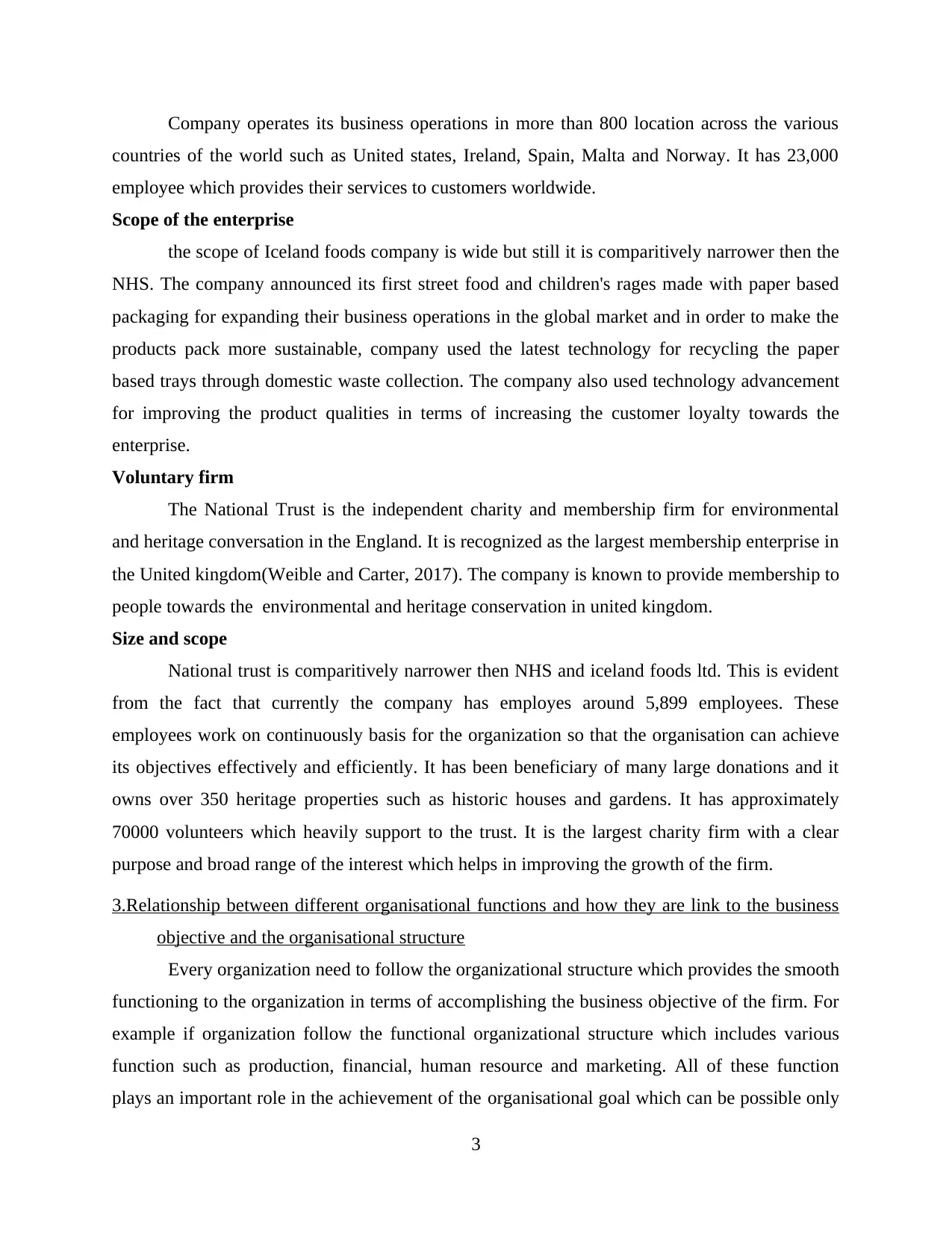
Company operates its business operations in more than 800 location across the various
countries of the world such as United states, Ireland, Spain, Malta and Norway. It has 23,000
employee which provides their services to customers worldwide.
Scope of the enterprise
the scope of Iceland foods company is wide but still it is comparitively narrower then the
NHS. The company announced its first street food and children's rages made with paper based
packaging for expanding their business operations in the global market and in order to make the
products pack more sustainable, company used the latest technology for recycling the paper
based trays through domestic waste collection. The company also used technology advancement
for improving the product qualities in terms of increasing the customer loyalty towards the
enterprise.
Voluntary firm
The National Trust is the independent charity and membership firm for environmental
and heritage conversation in the England. It is recognized as the largest membership enterprise in
the United kingdom(Weible and Carter, 2017). The company is known to provide membership to
people towards the environmental and heritage conservation in united kingdom.
Size and scope
National trust is comparitively narrower then NHS and iceland foods ltd. This is evident
from the fact that currently the company has employes around 5,899 employees. These
employees work on continuously basis for the organization so that the organisation can achieve
its objectives effectively and efficiently. It has been beneficiary of many large donations and it
owns over 350 heritage properties such as historic houses and gardens. It has approximately
70000 volunteers which heavily support to the trust. It is the largest charity firm with a clear
purpose and broad range of the interest which helps in improving the growth of the firm.
3.Relationship between different organisational functions and how they are link to the business
objective and the organisational structure
Every organization need to follow the organizational structure which provides the smooth
functioning to the organization in terms of accomplishing the business objective of the firm. For
example if organization follow the functional organizational structure which includes various
function such as production, financial, human resource and marketing. All of these function
plays an important role in the achievement of the organisational goal which can be possible only
3
countries of the world such as United states, Ireland, Spain, Malta and Norway. It has 23,000
employee which provides their services to customers worldwide.
Scope of the enterprise
the scope of Iceland foods company is wide but still it is comparitively narrower then the
NHS. The company announced its first street food and children's rages made with paper based
packaging for expanding their business operations in the global market and in order to make the
products pack more sustainable, company used the latest technology for recycling the paper
based trays through domestic waste collection. The company also used technology advancement
for improving the product qualities in terms of increasing the customer loyalty towards the
enterprise.
Voluntary firm
The National Trust is the independent charity and membership firm for environmental
and heritage conversation in the England. It is recognized as the largest membership enterprise in
the United kingdom(Weible and Carter, 2017). The company is known to provide membership to
people towards the environmental and heritage conservation in united kingdom.
Size and scope
National trust is comparitively narrower then NHS and iceland foods ltd. This is evident
from the fact that currently the company has employes around 5,899 employees. These
employees work on continuously basis for the organization so that the organisation can achieve
its objectives effectively and efficiently. It has been beneficiary of many large donations and it
owns over 350 heritage properties such as historic houses and gardens. It has approximately
70000 volunteers which heavily support to the trust. It is the largest charity firm with a clear
purpose and broad range of the interest which helps in improving the growth of the firm.
3.Relationship between different organisational functions and how they are link to the business
objective and the organisational structure
Every organization need to follow the organizational structure which provides the smooth
functioning to the organization in terms of accomplishing the business objective of the firm. For
example if organization follow the functional organizational structure which includes various
function such as production, financial, human resource and marketing. All of these function
plays an important role in the achievement of the organisational goal which can be possible only
3
⊘ This is a preview!⊘
Do you want full access?
Subscribe today to unlock all pages.

Trusted by 1+ million students worldwide
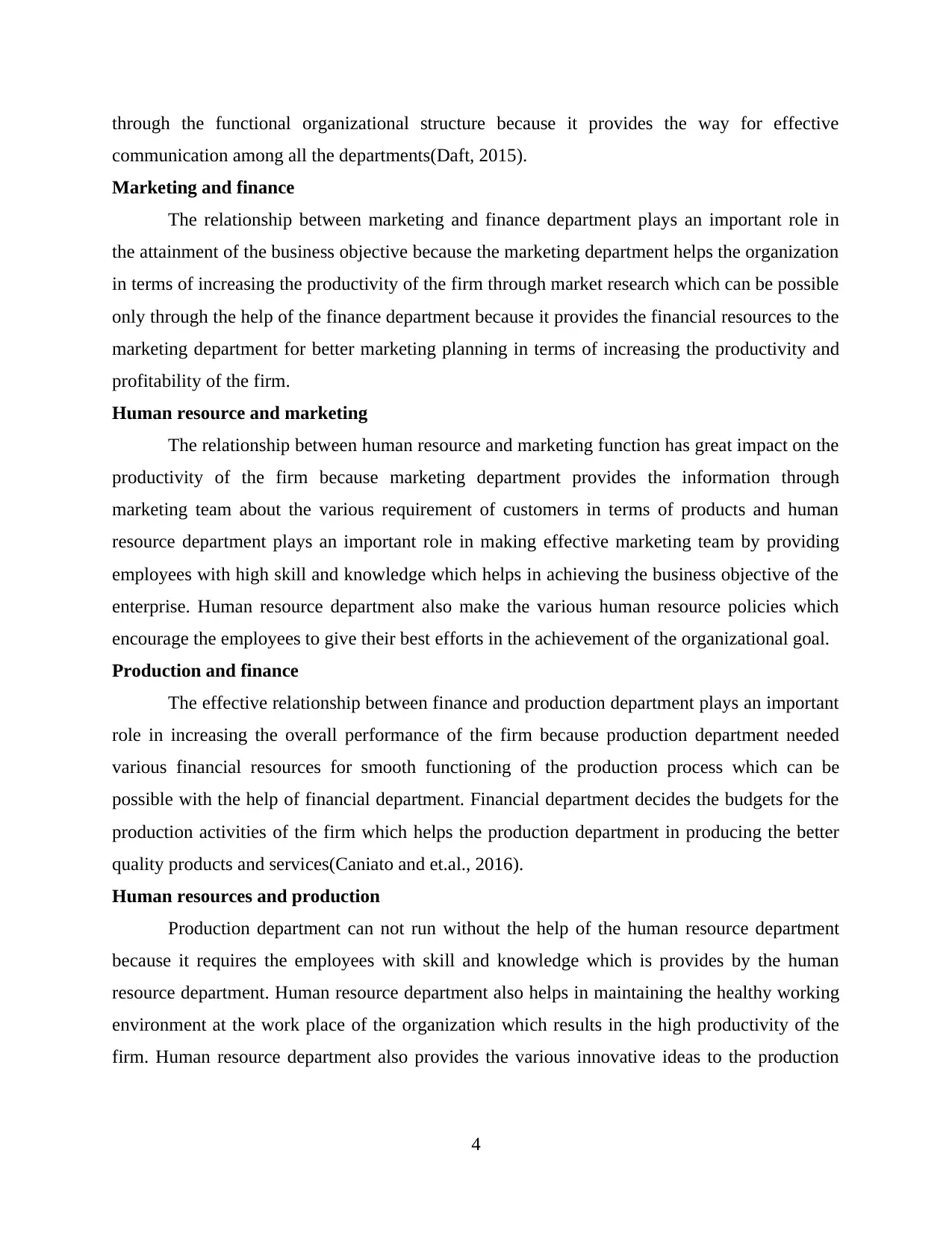
through the functional organizational structure because it provides the way for effective
communication among all the departments(Daft, 2015).
Marketing and finance
The relationship between marketing and finance department plays an important role in
the attainment of the business objective because the marketing department helps the organization
in terms of increasing the productivity of the firm through market research which can be possible
only through the help of the finance department because it provides the financial resources to the
marketing department for better marketing planning in terms of increasing the productivity and
profitability of the firm.
Human resource and marketing
The relationship between human resource and marketing function has great impact on the
productivity of the firm because marketing department provides the information through
marketing team about the various requirement of customers in terms of products and human
resource department plays an important role in making effective marketing team by providing
employees with high skill and knowledge which helps in achieving the business objective of the
enterprise. Human resource department also make the various human resource policies which
encourage the employees to give their best efforts in the achievement of the organizational goal.
Production and finance
The effective relationship between finance and production department plays an important
role in increasing the overall performance of the firm because production department needed
various financial resources for smooth functioning of the production process which can be
possible with the help of financial department. Financial department decides the budgets for the
production activities of the firm which helps the production department in producing the better
quality products and services(Caniato and et.al., 2016).
Human resources and production
Production department can not run without the help of the human resource department
because it requires the employees with skill and knowledge which is provides by the human
resource department. Human resource department also helps in maintaining the healthy working
environment at the work place of the organization which results in the high productivity of the
firm. Human resource department also provides the various innovative ideas to the production
4
communication among all the departments(Daft, 2015).
Marketing and finance
The relationship between marketing and finance department plays an important role in
the attainment of the business objective because the marketing department helps the organization
in terms of increasing the productivity of the firm through market research which can be possible
only through the help of the finance department because it provides the financial resources to the
marketing department for better marketing planning in terms of increasing the productivity and
profitability of the firm.
Human resource and marketing
The relationship between human resource and marketing function has great impact on the
productivity of the firm because marketing department provides the information through
marketing team about the various requirement of customers in terms of products and human
resource department plays an important role in making effective marketing team by providing
employees with high skill and knowledge which helps in achieving the business objective of the
enterprise. Human resource department also make the various human resource policies which
encourage the employees to give their best efforts in the achievement of the organizational goal.
Production and finance
The effective relationship between finance and production department plays an important
role in increasing the overall performance of the firm because production department needed
various financial resources for smooth functioning of the production process which can be
possible with the help of financial department. Financial department decides the budgets for the
production activities of the firm which helps the production department in producing the better
quality products and services(Caniato and et.al., 2016).
Human resources and production
Production department can not run without the help of the human resource department
because it requires the employees with skill and knowledge which is provides by the human
resource department. Human resource department also helps in maintaining the healthy working
environment at the work place of the organization which results in the high productivity of the
firm. Human resource department also provides the various innovative ideas to the production
4
Paraphrase This Document
Need a fresh take? Get an instant paraphrase of this document with our AI Paraphraser
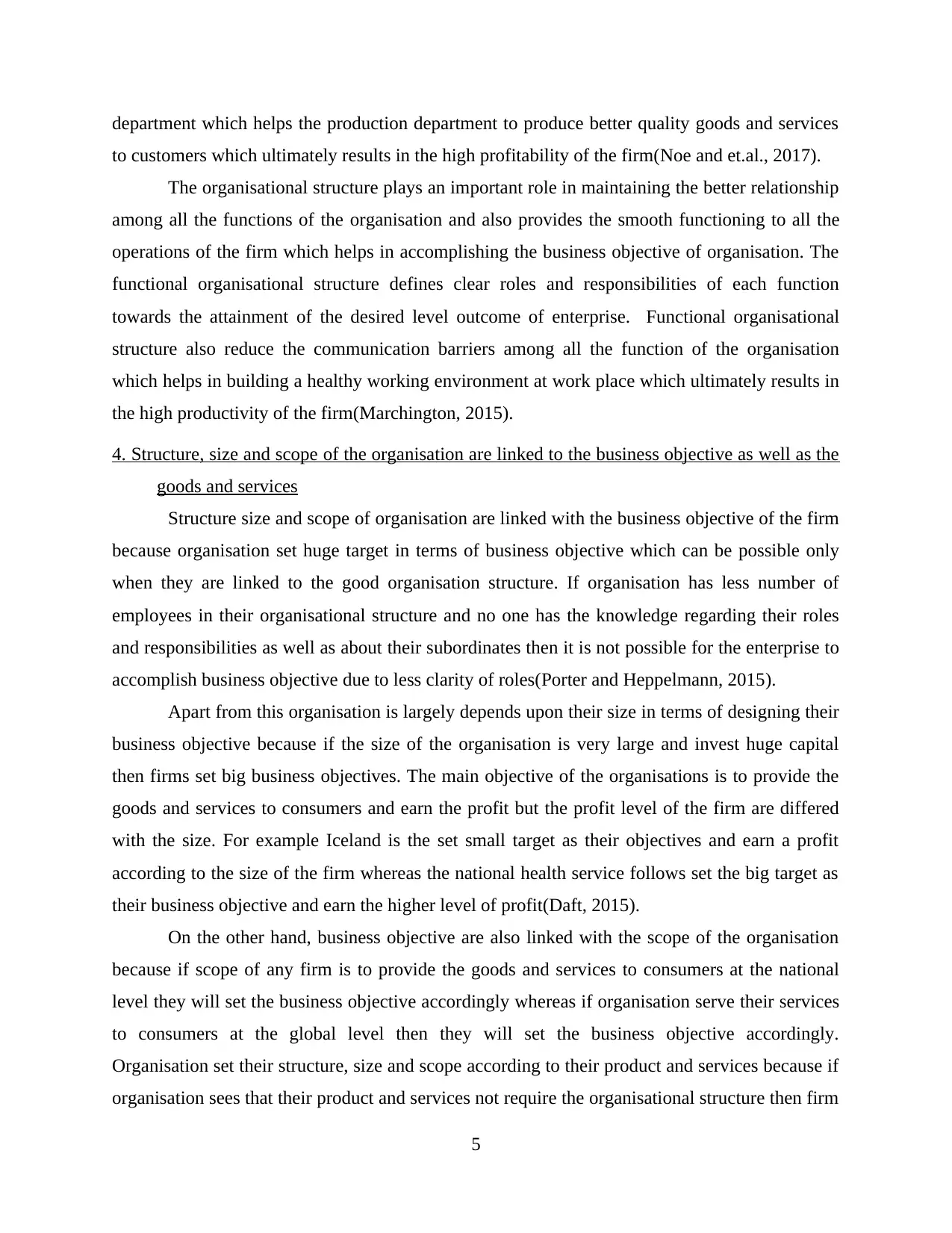
department which helps the production department to produce better quality goods and services
to customers which ultimately results in the high profitability of the firm(Noe and et.al., 2017).
The organisational structure plays an important role in maintaining the better relationship
among all the functions of the organisation and also provides the smooth functioning to all the
operations of the firm which helps in accomplishing the business objective of organisation. The
functional organisational structure defines clear roles and responsibilities of each function
towards the attainment of the desired level outcome of enterprise. Functional organisational
structure also reduce the communication barriers among all the function of the organisation
which helps in building a healthy working environment at work place which ultimately results in
the high productivity of the firm(Marchington, 2015).
4. Structure, size and scope of the organisation are linked to the business objective as well as the
goods and services
Structure size and scope of organisation are linked with the business objective of the firm
because organisation set huge target in terms of business objective which can be possible only
when they are linked to the good organisation structure. If organisation has less number of
employees in their organisational structure and no one has the knowledge regarding their roles
and responsibilities as well as about their subordinates then it is not possible for the enterprise to
accomplish business objective due to less clarity of roles(Porter and Heppelmann, 2015).
Apart from this organisation is largely depends upon their size in terms of designing their
business objective because if the size of the organisation is very large and invest huge capital
then firms set big business objectives. The main objective of the organisations is to provide the
goods and services to consumers and earn the profit but the profit level of the firm are differed
with the size. For example Iceland is the set small target as their objectives and earn a profit
according to the size of the firm whereas the national health service follows set the big target as
their business objective and earn the higher level of profit(Daft, 2015).
On the other hand, business objective are also linked with the scope of the organisation
because if scope of any firm is to provide the goods and services to consumers at the national
level they will set the business objective accordingly whereas if organisation serve their services
to consumers at the global level then they will set the business objective accordingly.
Organisation set their structure, size and scope according to their product and services because if
organisation sees that their product and services not require the organisational structure then firm
5
to customers which ultimately results in the high profitability of the firm(Noe and et.al., 2017).
The organisational structure plays an important role in maintaining the better relationship
among all the functions of the organisation and also provides the smooth functioning to all the
operations of the firm which helps in accomplishing the business objective of organisation. The
functional organisational structure defines clear roles and responsibilities of each function
towards the attainment of the desired level outcome of enterprise. Functional organisational
structure also reduce the communication barriers among all the function of the organisation
which helps in building a healthy working environment at work place which ultimately results in
the high productivity of the firm(Marchington, 2015).
4. Structure, size and scope of the organisation are linked to the business objective as well as the
goods and services
Structure size and scope of organisation are linked with the business objective of the firm
because organisation set huge target in terms of business objective which can be possible only
when they are linked to the good organisation structure. If organisation has less number of
employees in their organisational structure and no one has the knowledge regarding their roles
and responsibilities as well as about their subordinates then it is not possible for the enterprise to
accomplish business objective due to less clarity of roles(Porter and Heppelmann, 2015).
Apart from this organisation is largely depends upon their size in terms of designing their
business objective because if the size of the organisation is very large and invest huge capital
then firms set big business objectives. The main objective of the organisations is to provide the
goods and services to consumers and earn the profit but the profit level of the firm are differed
with the size. For example Iceland is the set small target as their objectives and earn a profit
according to the size of the firm whereas the national health service follows set the big target as
their business objective and earn the higher level of profit(Daft, 2015).
On the other hand, business objective are also linked with the scope of the organisation
because if scope of any firm is to provide the goods and services to consumers at the national
level they will set the business objective accordingly whereas if organisation serve their services
to consumers at the global level then they will set the business objective accordingly.
Organisation set their structure, size and scope according to their product and services because if
organisation sees that their product and services not require the organisational structure then firm
5
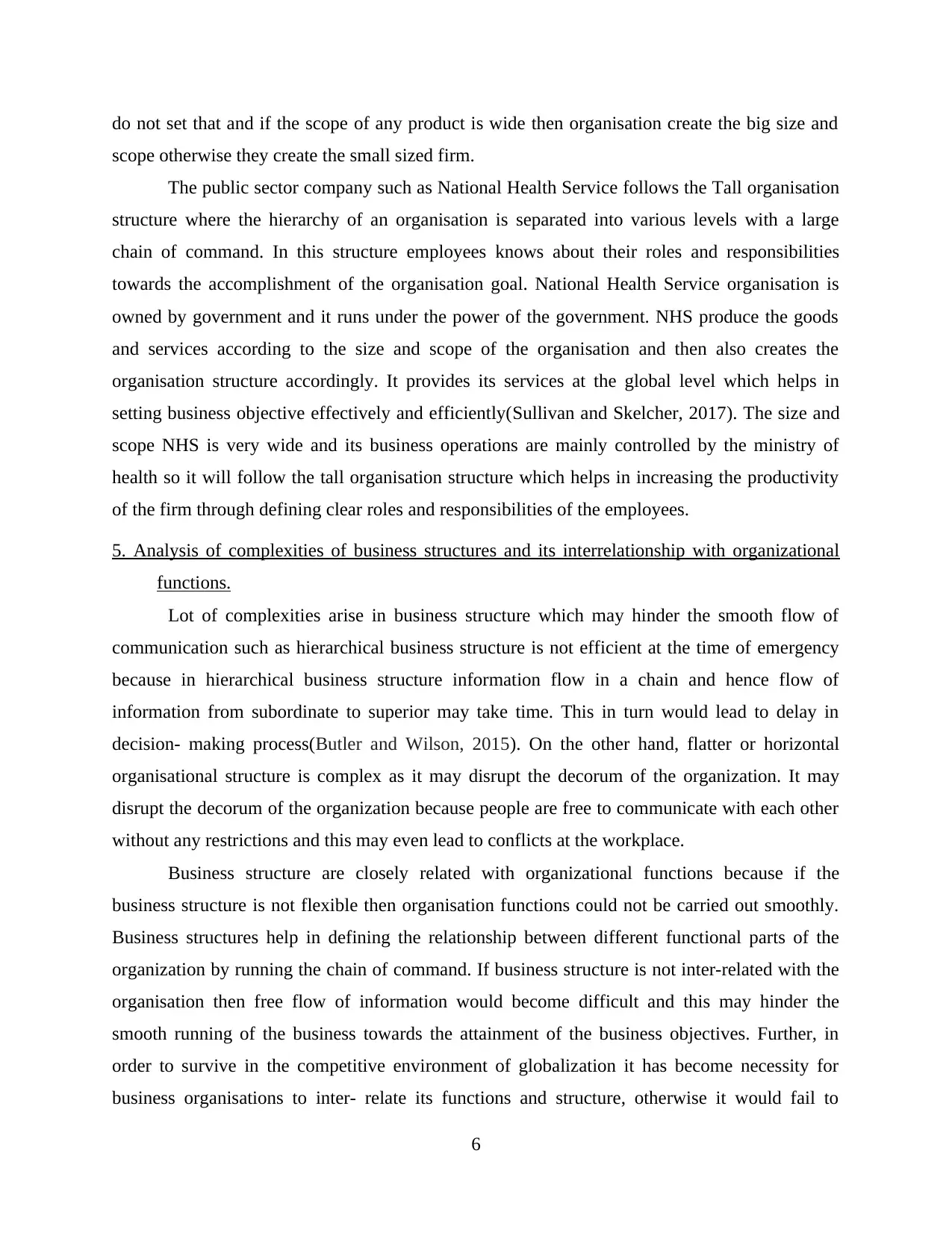
do not set that and if the scope of any product is wide then organisation create the big size and
scope otherwise they create the small sized firm.
The public sector company such as National Health Service follows the Tall organisation
structure where the hierarchy of an organisation is separated into various levels with a large
chain of command. In this structure employees knows about their roles and responsibilities
towards the accomplishment of the organisation goal. National Health Service organisation is
owned by government and it runs under the power of the government. NHS produce the goods
and services according to the size and scope of the organisation and then also creates the
organisation structure accordingly. It provides its services at the global level which helps in
setting business objective effectively and efficiently(Sullivan and Skelcher, 2017). The size and
scope NHS is very wide and its business operations are mainly controlled by the ministry of
health so it will follow the tall organisation structure which helps in increasing the productivity
of the firm through defining clear roles and responsibilities of the employees.
5. Analysis of complexities of business structures and its interrelationship with organizational
functions.
Lot of complexities arise in business structure which may hinder the smooth flow of
communication such as hierarchical business structure is not efficient at the time of emergency
because in hierarchical business structure information flow in a chain and hence flow of
information from subordinate to superior may take time. This in turn would lead to delay in
decision- making process(Butler and Wilson, 2015). On the other hand, flatter or horizontal
organisational structure is complex as it may disrupt the decorum of the organization. It may
disrupt the decorum of the organization because people are free to communicate with each other
without any restrictions and this may even lead to conflicts at the workplace.
Business structure are closely related with organizational functions because if the
business structure is not flexible then organisation functions could not be carried out smoothly.
Business structures help in defining the relationship between different functional parts of the
organization by running the chain of command. If business structure is not inter-related with the
organisation then free flow of information would become difficult and this may hinder the
smooth running of the business towards the attainment of the business objectives. Further, in
order to survive in the competitive environment of globalization it has become necessity for
business organisations to inter- relate its functions and structure, otherwise it would fail to
6
scope otherwise they create the small sized firm.
The public sector company such as National Health Service follows the Tall organisation
structure where the hierarchy of an organisation is separated into various levels with a large
chain of command. In this structure employees knows about their roles and responsibilities
towards the accomplishment of the organisation goal. National Health Service organisation is
owned by government and it runs under the power of the government. NHS produce the goods
and services according to the size and scope of the organisation and then also creates the
organisation structure accordingly. It provides its services at the global level which helps in
setting business objective effectively and efficiently(Sullivan and Skelcher, 2017). The size and
scope NHS is very wide and its business operations are mainly controlled by the ministry of
health so it will follow the tall organisation structure which helps in increasing the productivity
of the firm through defining clear roles and responsibilities of the employees.
5. Analysis of complexities of business structures and its interrelationship with organizational
functions.
Lot of complexities arise in business structure which may hinder the smooth flow of
communication such as hierarchical business structure is not efficient at the time of emergency
because in hierarchical business structure information flow in a chain and hence flow of
information from subordinate to superior may take time. This in turn would lead to delay in
decision- making process(Butler and Wilson, 2015). On the other hand, flatter or horizontal
organisational structure is complex as it may disrupt the decorum of the organization. It may
disrupt the decorum of the organization because people are free to communicate with each other
without any restrictions and this may even lead to conflicts at the workplace.
Business structure are closely related with organizational functions because if the
business structure is not flexible then organisation functions could not be carried out smoothly.
Business structures help in defining the relationship between different functional parts of the
organization by running the chain of command. If business structure is not inter-related with the
organisation then free flow of information would become difficult and this may hinder the
smooth running of the business towards the attainment of the business objectives. Further, in
order to survive in the competitive environment of globalization it has become necessity for
business organisations to inter- relate its functions and structure, otherwise it would fail to
6
⊘ This is a preview!⊘
Do you want full access?
Subscribe today to unlock all pages.

Trusted by 1+ million students worldwide
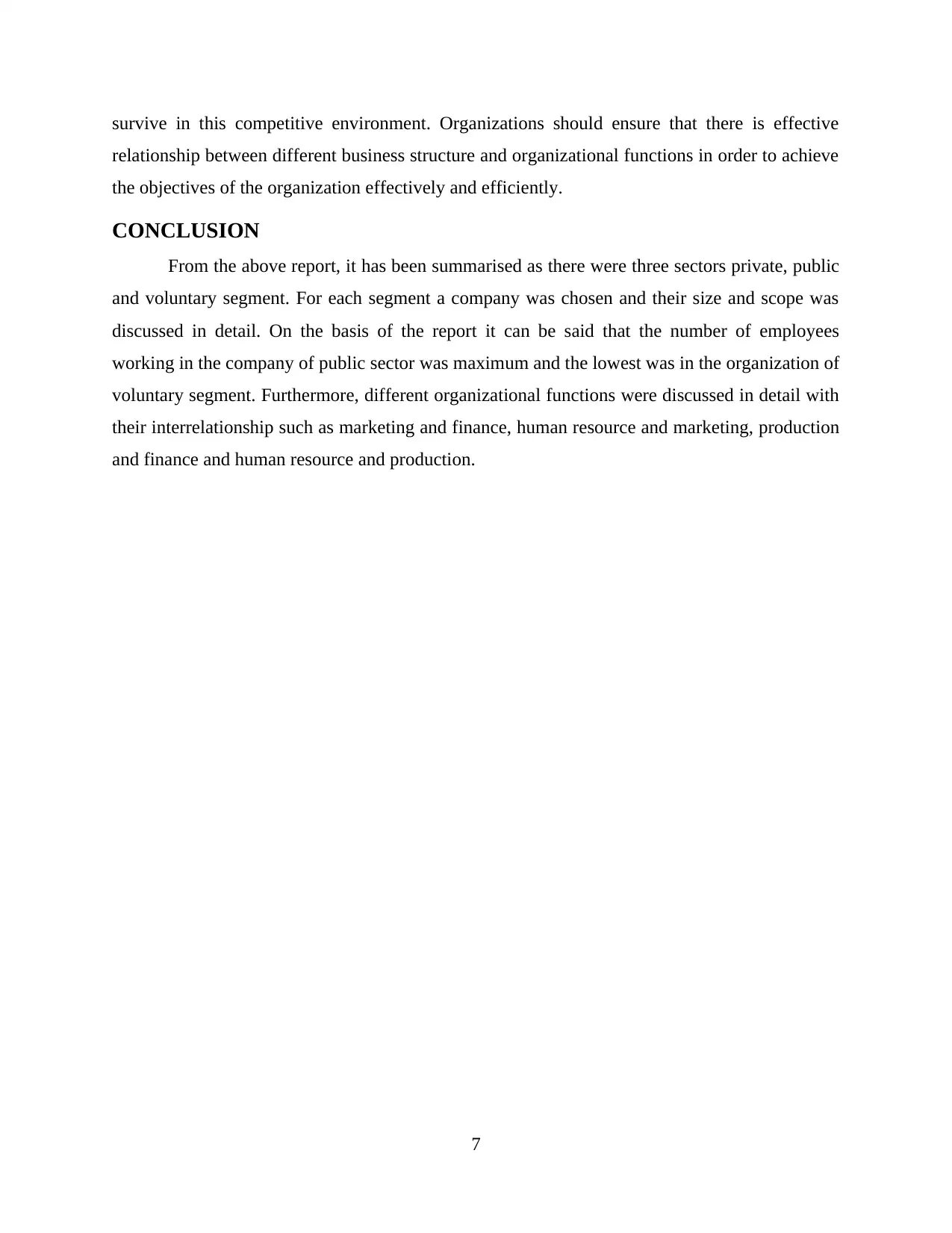
survive in this competitive environment. Organizations should ensure that there is effective
relationship between different business structure and organizational functions in order to achieve
the objectives of the organization effectively and efficiently.
CONCLUSION
From the above report, it has been summarised as there were three sectors private, public
and voluntary segment. For each segment a company was chosen and their size and scope was
discussed in detail. On the basis of the report it can be said that the number of employees
working in the company of public sector was maximum and the lowest was in the organization of
voluntary segment. Furthermore, different organizational functions were discussed in detail with
their interrelationship such as marketing and finance, human resource and marketing, production
and finance and human resource and production.
7
relationship between different business structure and organizational functions in order to achieve
the objectives of the organization effectively and efficiently.
CONCLUSION
From the above report, it has been summarised as there were three sectors private, public
and voluntary segment. For each segment a company was chosen and their size and scope was
discussed in detail. On the basis of the report it can be said that the number of employees
working in the company of public sector was maximum and the lowest was in the organization of
voluntary segment. Furthermore, different organizational functions were discussed in detail with
their interrelationship such as marketing and finance, human resource and marketing, production
and finance and human resource and production.
7
Paraphrase This Document
Need a fresh take? Get an instant paraphrase of this document with our AI Paraphraser
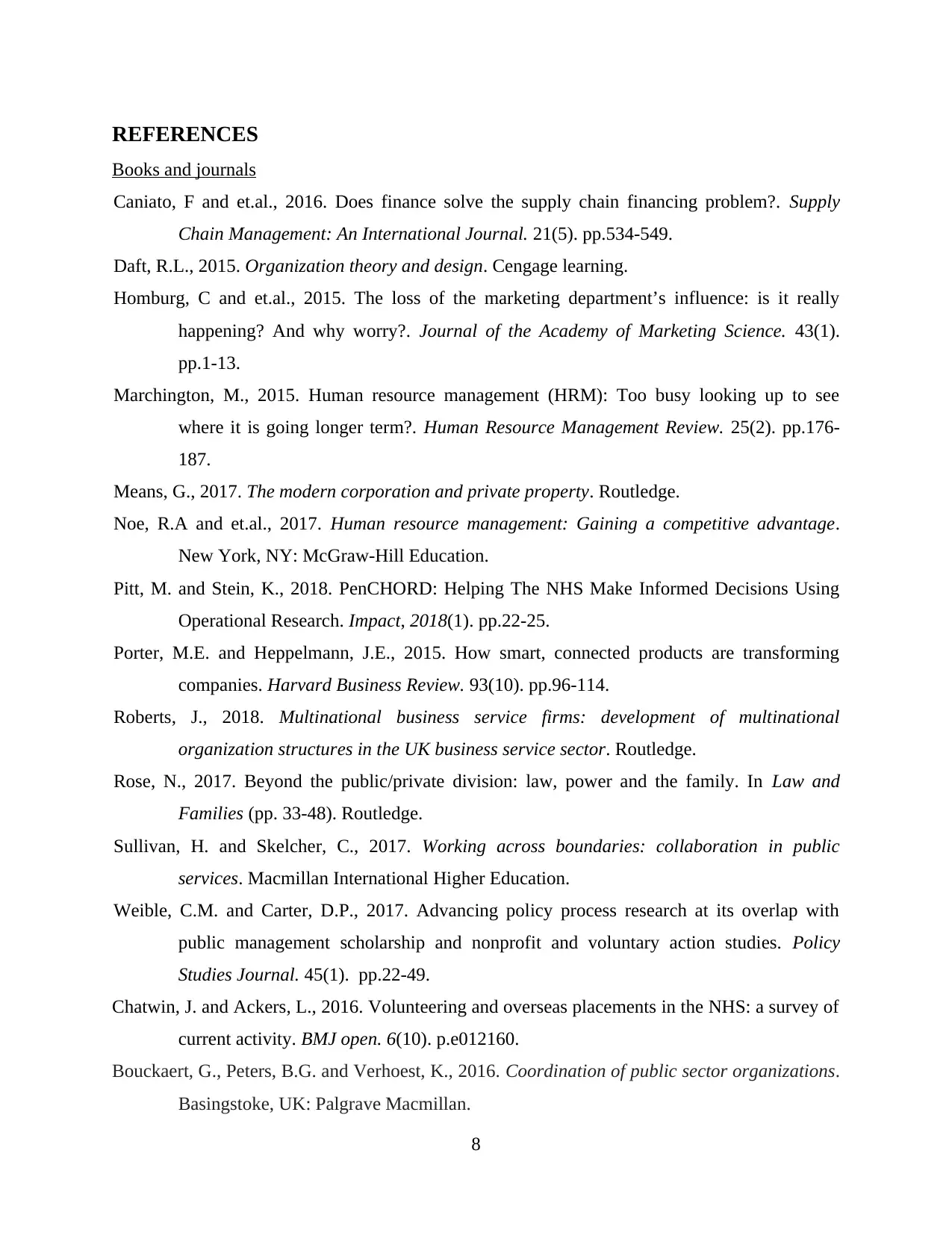
REFERENCES
Books and journals
Caniato, F and et.al., 2016. Does finance solve the supply chain financing problem?. Supply
Chain Management: An International Journal. 21(5). pp.534-549.
Daft, R.L., 2015. Organization theory and design. Cengage learning.
Homburg, C and et.al., 2015. The loss of the marketing department’s influence: is it really
happening? And why worry?. Journal of the Academy of Marketing Science. 43(1).
pp.1-13.
Marchington, M., 2015. Human resource management (HRM): Too busy looking up to see
where it is going longer term?. Human Resource Management Review. 25(2). pp.176-
187.
Means, G., 2017. The modern corporation and private property. Routledge.
Noe, R.A and et.al., 2017. Human resource management: Gaining a competitive advantage.
New York, NY: McGraw-Hill Education.
Pitt, M. and Stein, K., 2018. PenCHORD: Helping The NHS Make Informed Decisions Using
Operational Research. Impact, 2018(1). pp.22-25.
Porter, M.E. and Heppelmann, J.E., 2015. How smart, connected products are transforming
companies. Harvard Business Review. 93(10). pp.96-114.
Roberts, J., 2018. Multinational business service firms: development of multinational
organization structures in the UK business service sector. Routledge.
Rose, N., 2017. Beyond the public/private division: law, power and the family. In Law and
Families (pp. 33-48). Routledge.
Sullivan, H. and Skelcher, C., 2017. Working across boundaries: collaboration in public
services. Macmillan International Higher Education.
Weible, C.M. and Carter, D.P., 2017. Advancing policy process research at its overlap with
public management scholarship and nonprofit and voluntary action studies. Policy
Studies Journal. 45(1). pp.22-49.
Chatwin, J. and Ackers, L., 2016. Volunteering and overseas placements in the NHS: a survey of
current activity. BMJ open. 6(10). p.e012160.
Bouckaert, G., Peters, B.G. and Verhoest, K., 2016. Coordination of public sector organizations.
Basingstoke, UK: Palgrave Macmillan.
8
Books and journals
Caniato, F and et.al., 2016. Does finance solve the supply chain financing problem?. Supply
Chain Management: An International Journal. 21(5). pp.534-549.
Daft, R.L., 2015. Organization theory and design. Cengage learning.
Homburg, C and et.al., 2015. The loss of the marketing department’s influence: is it really
happening? And why worry?. Journal of the Academy of Marketing Science. 43(1).
pp.1-13.
Marchington, M., 2015. Human resource management (HRM): Too busy looking up to see
where it is going longer term?. Human Resource Management Review. 25(2). pp.176-
187.
Means, G., 2017. The modern corporation and private property. Routledge.
Noe, R.A and et.al., 2017. Human resource management: Gaining a competitive advantage.
New York, NY: McGraw-Hill Education.
Pitt, M. and Stein, K., 2018. PenCHORD: Helping The NHS Make Informed Decisions Using
Operational Research. Impact, 2018(1). pp.22-25.
Porter, M.E. and Heppelmann, J.E., 2015. How smart, connected products are transforming
companies. Harvard Business Review. 93(10). pp.96-114.
Roberts, J., 2018. Multinational business service firms: development of multinational
organization structures in the UK business service sector. Routledge.
Rose, N., 2017. Beyond the public/private division: law, power and the family. In Law and
Families (pp. 33-48). Routledge.
Sullivan, H. and Skelcher, C., 2017. Working across boundaries: collaboration in public
services. Macmillan International Higher Education.
Weible, C.M. and Carter, D.P., 2017. Advancing policy process research at its overlap with
public management scholarship and nonprofit and voluntary action studies. Policy
Studies Journal. 45(1). pp.22-49.
Chatwin, J. and Ackers, L., 2016. Volunteering and overseas placements in the NHS: a survey of
current activity. BMJ open. 6(10). p.e012160.
Bouckaert, G., Peters, B.G. and Verhoest, K., 2016. Coordination of public sector organizations.
Basingstoke, UK: Palgrave Macmillan.
8

Butler, R. and Wilson, D.C., 2015. Managing voluntary and non-profit organizations: Strategy
and structure. Routledge.
Shen, K. and et.al., 2015. Network structure shapes spontaneous functional connectivity
dynamics. Journal of Neuroscience. 35(14). pp.5579-5588.
9
and structure. Routledge.
Shen, K. and et.al., 2015. Network structure shapes spontaneous functional connectivity
dynamics. Journal of Neuroscience. 35(14). pp.5579-5588.
9
⊘ This is a preview!⊘
Do you want full access?
Subscribe today to unlock all pages.

Trusted by 1+ million students worldwide
1 out of 12
Related Documents
Your All-in-One AI-Powered Toolkit for Academic Success.
+13062052269
info@desklib.com
Available 24*7 on WhatsApp / Email
![[object Object]](/_next/static/media/star-bottom.7253800d.svg)
Unlock your academic potential
Copyright © 2020–2025 A2Z Services. All Rights Reserved. Developed and managed by ZUCOL.





